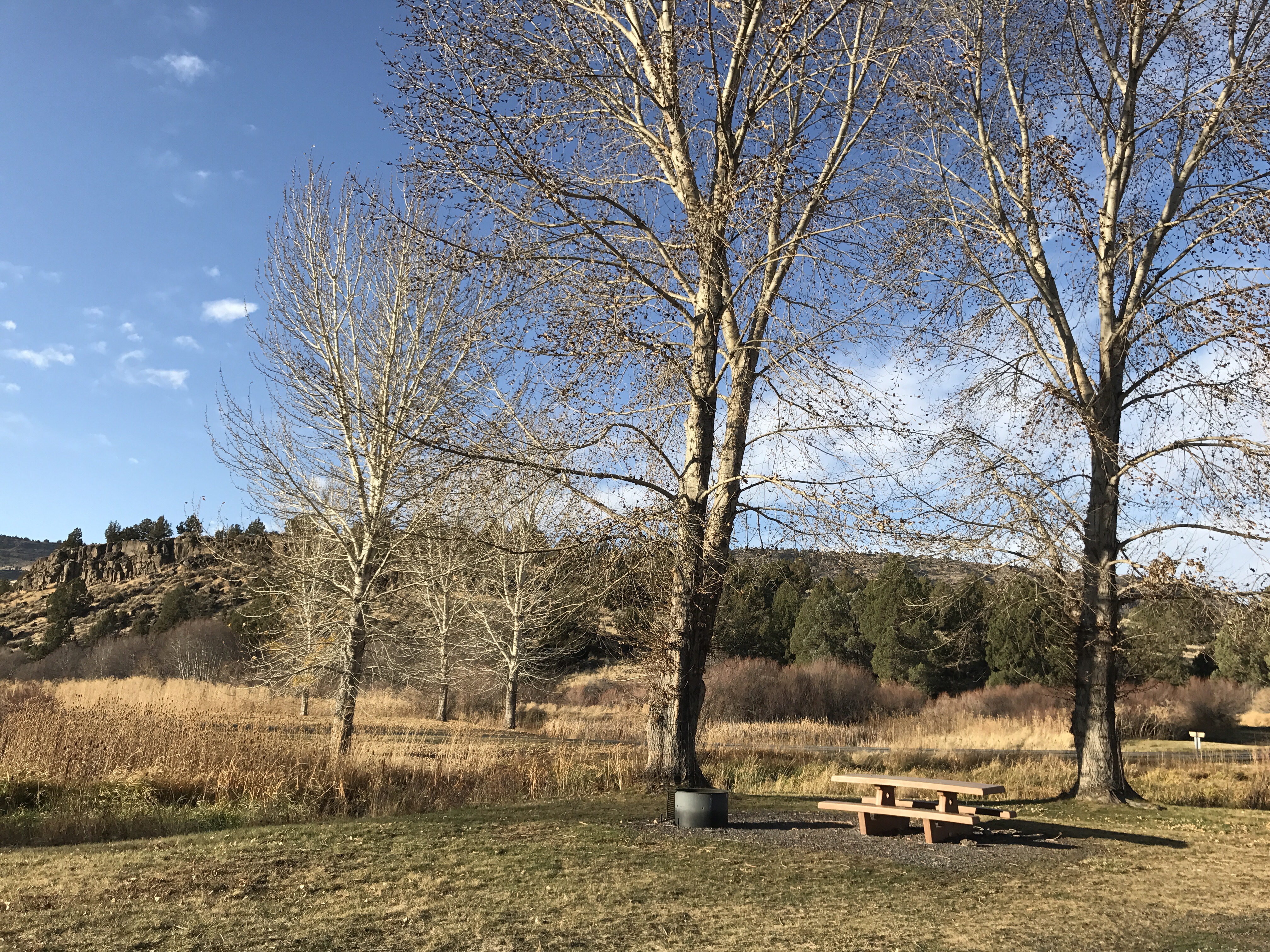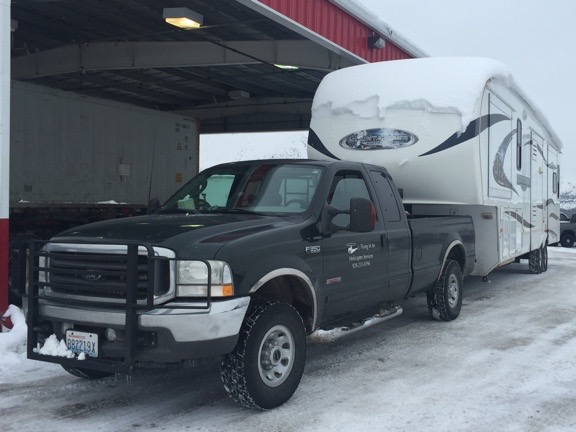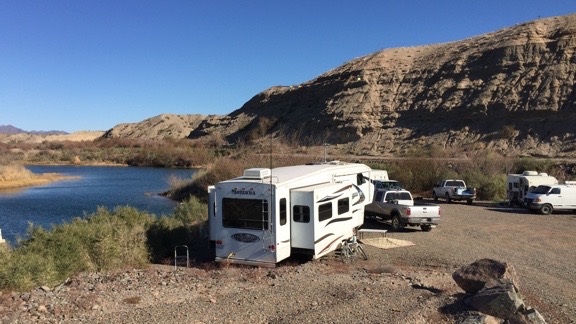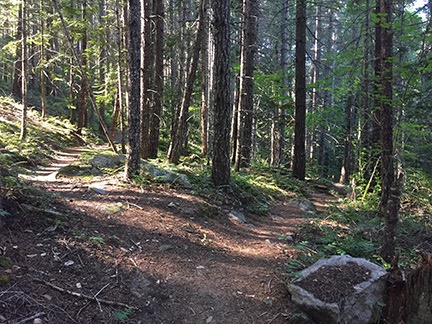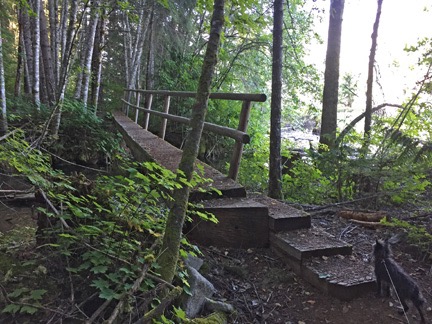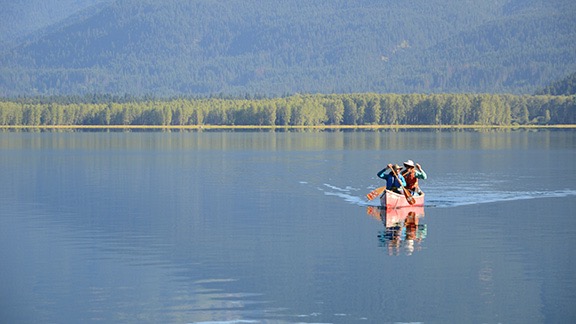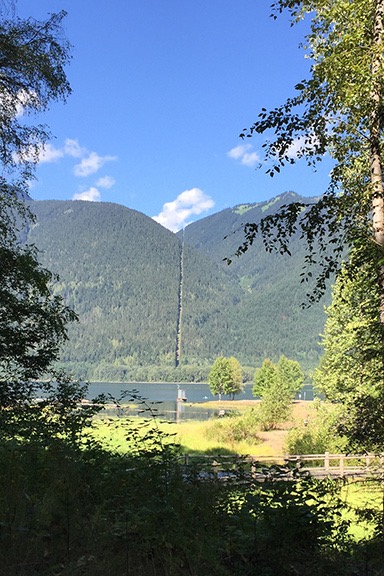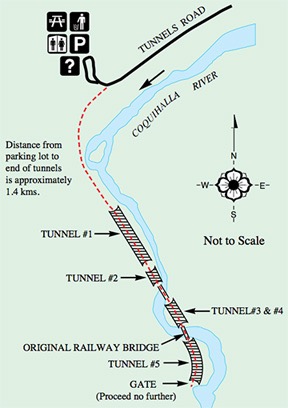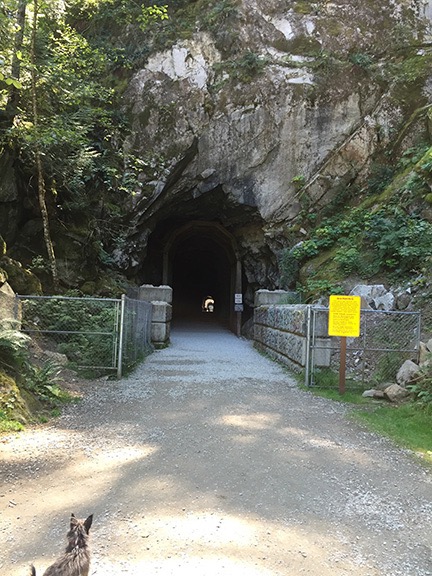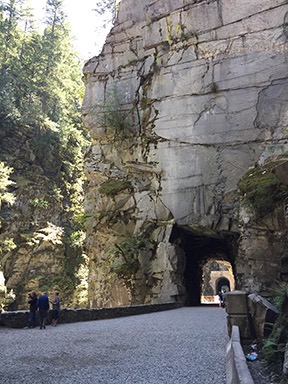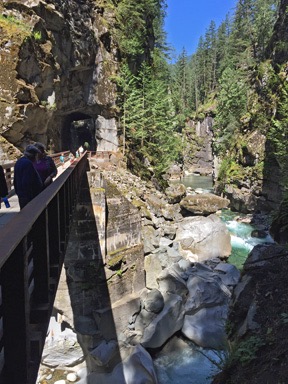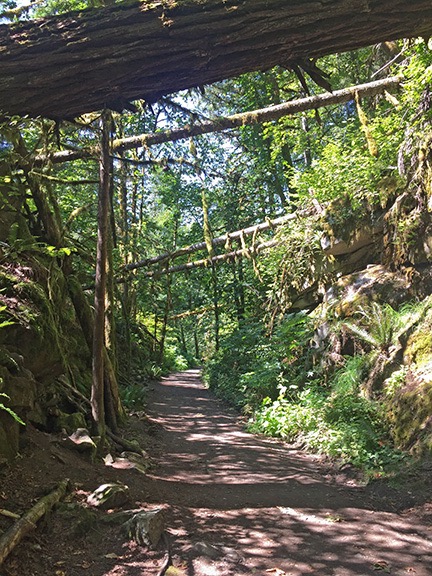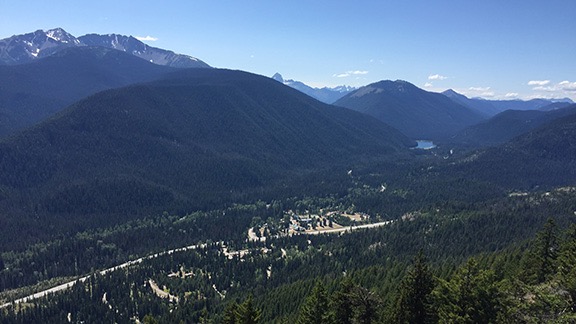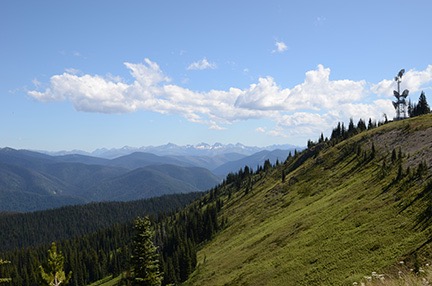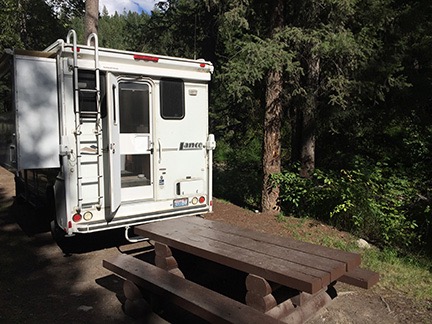A few short hikes and a sweet creekside campsite.
I slept with the camper’s door open (and screen door closed, of course) for the first time. Unlike my other overnight stops, I suspected it would stay warm enough overnight and it did.
I slept really well until around midnight when I woke up with a weird allergy attack. I read until the faucet in my nose turned itself off. Even then, it wasn’t easy to get back to sleep. The frogs were really croaking! I didn’t mind being kept up for that, though. It’s desertlike where I live and there aren’t any frogs.
It was getting light when I woke up. I worked on a blog post, getting it ready to publish, while I had my coffee with some cereal and the last of the blueberries I’d picked a full week before. (It’s amazing how long they stay fresh when you pick them yourself.) By the time I was ready to emerge from the Turtleback for the day, the lake was glassy smooth. I grabbed my camera and shot a few photos of the reflections with the morning sun shining on the opposite shore.

One of the boat docks at Winebago Flats. Ross Lake was glassy smooth in the morning.
Meanwhile, the folks who had held my campsite for me were packing up to leave. I thought that odd — they had a canoe on the roof of their car. Surely they didn’t drive all the way down to Hozomeen to just to camp for one night. I said goodbye and thanked them again as they climbed into their car. They turned right instead of left when they left — maybe they were going to put that canoe in the water after all.
I’d already packed up my campsite the night before — it’s important to keep a clean campsite when there are bears in the area — so there wasn’t anything else to do before leaving.
Except take a hike, of course.
The Lakeside Trail
Penny and I set off on the same trail we’d taken to the campground the afternoon before, this time heading downlake. It was wonderfully cool — even the shoreline was in the shade — and quiet. I walked at a good pace, stopping every now and then to look around me and maybe take a photo. I admit that I spent more than my fair share of time wondering if the local bear would put in an appearance; I did see some relatively fresh bear scat along the lake.

Along the trail from Winnebago Flats to the Hozomeen Campground boat ramp.

A fork in the lakeside trail at Hozomeen.
I could hear the rushing of Hozomeen Creek long before I got to where the trail split. I knew from the previous day’s hike that the left fork would take us up to the road near Ranger Housing. Where would the right fork take us? To the lake, I assumed. But would there be a bridge across the creek?

The shorter of two split log bridges across Hozomeen Creek near Ross Lake.
The answer was yes. There were actually two bridges, each of which were created by splitting a log so it had a flat walking surface and then attaching a handrail to it. I was impressed by the first one, but the second one, which had to be close to 100 feet long, blew me away. Had the logs fallen there naturally and then been turned into bridges? Or did someone actually put them in place? I couldn’t imagine getting any heavy equipment in there.
After the bridges, the trail wound down to the boat ramp. And that’s where I saw my two camping neighbors. They were at the ramp with their canoe upside down. The woman was fanning the bottom of the canoe with a foam pad while the man stood by, waiting. Their gear, in dry bags, was neatly organized nearby.
We got to talking (of course). It seems that when they launched the canoe, it began taking on water. They were repairing the bottom with duct tape. Neither of these things surprised me. The canoe looked old and very well used. It had other signs of patches in its fiberglas bottom. And duct tape — well, you use what you’ve got. They were cleaning and drying each area before applying the tape and putting multiple layers on. They seemed pretty confident that their repairs would hold. Then they’d be out for an overnight camping trip along the lake.
We chatted while the woman made the repairs. We talked about the north and south ends of the lake and how Americans had to come all the way up to Canada to launch a boat. We talked about hiking trails in the North Cascades National Park and how US parks had better trails than Canadian parks (their opinion; I didn’t have enough data to come to any conclusion). The conversation inevitably turned to politics. Seriously: Canadians are very worried about Donald Trump becoming president. Even when I tried to steer the conversation somewhere else, it led back. I learned a little more about Canadian politics, too.
Finally, their boat was patched sufficiently and we were all ready to move on. We said our goodbyes and I continued hiking, now up the road to the boat ramp. The previous day, I’d noticed a trail that continued down toward the lake. Maps showed that it went down to a point of land — you can see it in the photo above. So Penny and I plunged back into the forest, in the strip of land between the campground we’d first parked in and the lake.

This was one very pissed off squirrel.
At one point, Penny saw a squirrel and chased it up a tree. It ran up 20 or more feet, then turned and started making really weird little noises at us. I had to record a video. (I just played it and Penny went nuts.)
I’ve never heard a sound like this out of an animal.
We went off the trail briefly to walk down to the lake’s edge. The water was deep right off the shore there with a series of rock shelves that would make a great point for getting in and out of the water. A perfect swimming hole on a hot day.
In the distance, I could see my canoeing friends paddling toward us on the glassy smooth water. I envied them, in a way. It was an absolutely perfect day for paddling and I wished I could be out there, too. I expected them to continue right past me with a wave and final goodbye, but they paddled right up to where I was standing. Then they proceeded to tell me about other places along my route of travel that might interest me: the Othello Tunnels, the wildflower meadow at Manning Park, and the mine tour at Hedley. I committed all of this to memory (somehow), including driving directions and other tips.

Nice day for a paddle, eh?
At one point, the woman reached down into the water and exclaimed “It’s so warm! Like bathwater! Feel it!” I had my doubts — after all, this was a mountain lake on the Canadian border — but I did as she asked and dipped a hand in. She was right: it was very warm. Seeing people in the water at Winnebago Flats the previous afternoon no longer surprised me.
We chatted a while longer, then all got on our way.
The trail ended at a bench overlooking the lake. Well, kind of overlooking the lake — there were enough trees in front of the bench that sitting at it wouldn’t give you much of a view. I got a last look at my canoeing friends far down the lake, paddling a few hundred feet out from the shoreline.
Penny and I turned around and headed back the way we’d come. Total distance hiked was 2.8 miles. Not bad for an easy morning hike. Interested in a track log with photos? Here you go: Hozomeen Lakeside.
The Othello Tunnels

The border between the US and Canada is easily visible as a clearing between the two countries. It’s all ready for Donald Trump’s northern wall. Or, more likely, the wall the Canadians would put up to keep out Americans if Trump were elected.
Since we were already all packed up, all I had to do was visit my tiny bathroom — the pit toilets at Winnebago Flats were not something I was willing to face — and close up the Turtleback’s slide. Then we were back in the truck and heading north. I made one stop at the border and that was to take two photos. One was the border sign I showed in the previous day’s blog post. The other was of the actual border, which you can see as a clearing that stretches as far as the eye can see in either direction.
The road north started out smooth and became progressively rougher as I continued north. The more use it got for Canadian parks along its length, the rougher it became. I was glad to reach that sorry excuse for pavement and even gladder to reach the main road in Hope an hour after leaving the park.
I stopped alongside the road and uploaded two blog posts and a handful of track logs. I didn’t bother checking email — nothing of interest had arrived the last time I’d checked. Besides, I was rather enjoying the illusion of being off-the-grid even when I technically wasn’t. Like most connected people, I spend far too much time looking at a computer.
I eventually got on the main road and found my way to Route 3. Then I took the exit for Route 5, looking for the Othello Tunnels. It wasn’t far off my route. I steered my way along a side road and into a very tight parking lot. I was immediately glad again that I’d shed my Mobile Mansion for the Turtleback — I could park in a regular spot. There’s no way I could have parked anywhere nearby towing a virtual house behind me.
The place was crowded with families and people walking dogs — it was a Saturday, after all. It was after noon and I was hungry and not at all in a hurry so Penny and I climbed into the Turtleback and I made myself a nice lunch: sardines I’d bought at Trader Joe’s the previous week with some diced onion on some of that multigrain bread I’d bought my first day in Canada. (It never seemed to go stale.) Then I gathered together my camera and a water bottle and climbed back down into the parking lot with Penny on a leash and headed for the trailhead.
The Othello Tunnels are a series of five old railroad tunnels built into the side of Coquihalla Canyon, a 300-foot deep channel cut in solid granite by the Coquihalla River. They were (and are) an engineering marvel that combined tunnels and bridges, making it possible for the railroad to get through a difficult area instead of having to go around it.

Penny looked eager to go into the first of the five tunnels.
Although there were a lot of people on the trail, it was plenty wide. It descended at a gentle grade — after all, it had been a train route once — through the woods with plenty of places to look down at the roaring river beside it. The first tunnel began not long after the river entered the gorge it had created. The longest of the tunnels, it got very dark in the middle. A few hikers had flashlights. Penny walked along with me, a tiny shadow at the end of her leash.
On the other end, it was bright and sunny and the river roared through the gorge beside us. The next tunnel started almost immediately. It was a lot shorter and never got very dark. Then there was a bridge and tunnels 3 and 4, which really didn’t have any space between them. Another bridge over the river and then the final tunnel, which had a bend to it.
We walked along at a good pace, stopping between tunnels to look out over the river and gorge. It was a really beautiful place and I tried to imagine what it must have been like to be on a train going along this route. Terrifying, likely, to a passenger.


I stopped to take photos between the tunnels — it made no sense to take photos inside them. The gorge was actually quite beautiful. The water gets its color from glacial “flour” — silt in melting glaciers.

The trail beyond the last tunnel is mostly in a cut in the granite walls.
We kept walking past the last tunnel. The trail continues on, mostly in a cut that’s canopied, in some places, by fallen, moss-covered trees. Fewer people were on this part of the trail; most seemed to walk through the tunnels and back. We walked as far as another gate, which was also open, and then turned back. The tunnels were darker on the way back because of the direction of the sun, especially that long first tunnel.
Want a track log for this little hike? My GPS said we did more than 3 miles, but I’m not sure how accurate that is since it likely lost contact with satellites inside the tunnels and there are some odd-looking elevation spikes in the track log graph. But here’s what I uploaded, with photos: Othello Tunnels.
In Manning Park
Back in the truck, I headed out, taking a few minutes to chat with my sister (via the trucks’s bluetooth audio) along the way. I like to check in periodically to make sure I’m not missing anything important. I wasn’t.
I lost the cell connection as I headed eastbound on Route 3, the so-called Crowsnest Highway. This road runs a zigzag course through the south end of British Columbia, winding around heavily trees mountains and through valleys. It wasn’t long before the road passed into EC Manning Provincial Park, which must be one of the larger parks in British Columbia. It has lots of trails and campgrounds, and points of interest. It even has a ski resort.
I saw the sign for the Wildflower Meadow and turned left. The narrow road immediately began climbing steeply up the side of a mountain. It went on for a few miles before there was a view point. I was one of about five vehicles that turned in. I let Penny out, leashless, and she immediately began chasing chipmunks that hid in the drainage openings of the curb. It was pretty entertaining for onlookers. The view from up there, at least 2,000 feet above the valley floor, was amazing. A sign pointed out the names of various peaks, including Hozomeen Mountain (which looked very close) and Mount Winthrop, both of which are in the US. Far below us, I could see the resort area for the park, with its restaurant, lodging, and other amenities.

The view from the overlook on the road to the Wildflower Meadow at Manning Park.
Penny and I continued the climb. There was a trailhead parking area and we kept going. Then the road ended at another trailhead. Parking was tough, but I found a spot alongside the road. I put Penny on a leash and we set out to explore the Paintbrush Trail.

There weren’t many wildflowers at Wildflower Meadow, but there was a massive antenna installation and an even better view. This is looking southeast.
The trail likely gets its name from the only flower still blooming: Indian Paintbrush. But even those had already faded. Between the cold nights at that elevation — over 6,000 feet — and the lack of rainfall, the flowers were already gone. I imagine it must be something in spring or early summer, but at the end of the first week in August, it’s a bust. (My canoeing friends warned me that it might be too late in the season for flowers.) We did a short hike anyway — maybe a mile — and admired both the view and the massive antenna array that guaranteed me a cell signal. Then we went back to the truck and retraced our route down the mountain.
Copper Creek
By this time, it was after 5 PM and I was starting to think about a place to spend the night. My trip planning had pretty much ended the day before and now I was making up everything as I went along. So I started by driving into the resort area, following a sign to Lightning Lake campground. That was full, but there was a ranger at the booth and I asked her about camping possibilities. She told me that camping in the park is only allowed in designated sites and that there might be a few available in other campgrounds. She gave me a map and circled three of them, two of which were on my route east. I thanked her, turned around, and headed back out to Route 3.
I skipped the first campground, mostly because it was right on the main road, and pulled into the second one, which was about 10 kilometers from the resort turn. This one was almost full. There were two sites that weren’t reserved or taken and both were on the main road. The idea of paying $25 to camp in such a full campground so close to a highway really bugged me. So I left and we continued on our way.
We passed out of the park. I looked for camping possibilities. I suspected I’d have to go off on a side road, but I had no idea where to try. A bunch of signs warned about road work and flagmen up ahead so I slowed down. I got to a bend in the road where a woman was turning around a truck at an intersection where a gravel road went off to the right. There were lots of road work signs. I stopped beside her and rolled down my window. “Are you a pilot car?” I asked.
She looked surprised. “No,” she replied.
I pointed down the road beside us. “Where does that go?”
She gave me a huge shrug. “I don’t know, but Copper Creek is down there.”
“Any camping?”
“I don’t know,” she said.
I thanked her and let her pull away. Then I turned right down the road toward Copper Creek.
The road was obviously a logging road — signs at the beginning provided information about radio calls and warned, “No seatbelt, no job.” I proceeded cautiously. I didn’t have far to go. About a quarter mile down the road was a bridge over a creek. And right before the bridge was a clearing with a picnic table and fire pit. No, two picnic tables with firepits. I slowed to a stop and looked at the sign: Copper Creek Recreation Area. I turned in.
It was a tiny campground with 5 sites, three of which were right on the creek, and a pit toilet. No one else was there. The $12 fee would be collected by “an attendant.”

My campsite at Copper Creek. The creek is right beyond the trees to the right of the Turtleback.
After scouting the area — including some minor road damage from erosion — I chose a campsite and backed into it. I had trouble getting the Turtleback level and wound up backing up almost all the way to the picnic table. When I was satisfied with what the level said, I put the truck in park and shut it off. (Unfortunately, I misread the level and we were camped on a bit of an angle for the night. I have since ordered leveling blocks.) I let Penny out and went about setting up my grill to make dinner: sausages with salad and garden tomatoes.
The site, which was about 10 feet from the creek, was extremely pleasant with the sound of flowing water. If the road was for logging, either the loggers were done for the day or had the weekend off. No other campers showed up. No attendant showed up, either. I had dinner outside at the picnic table, and then, when the sun dipped below the trees, I went in for the evening.
I didn’t realize it then, but it would be my last night on vacation.



